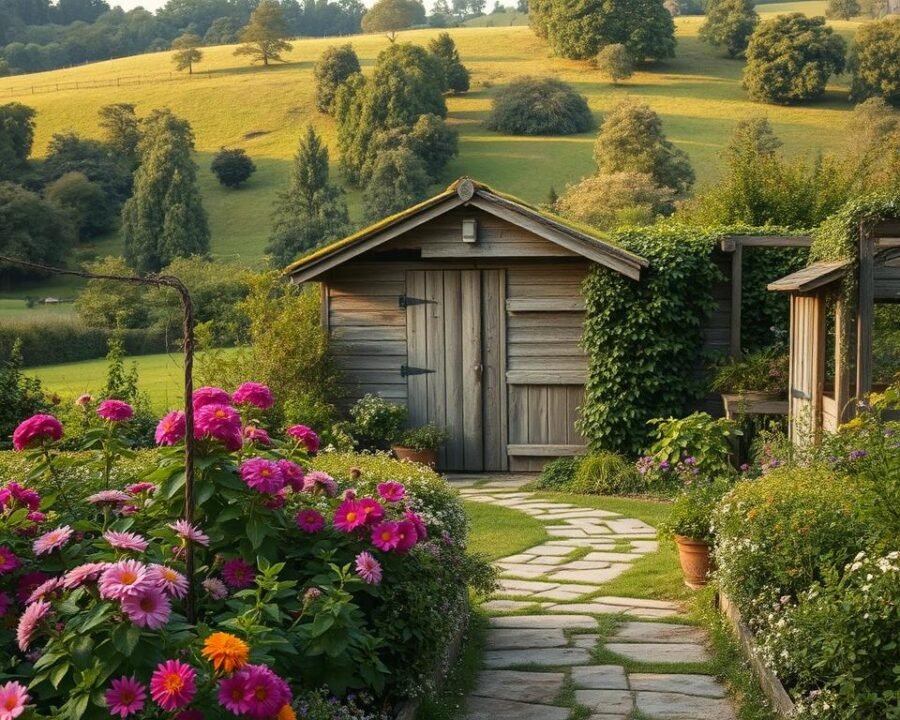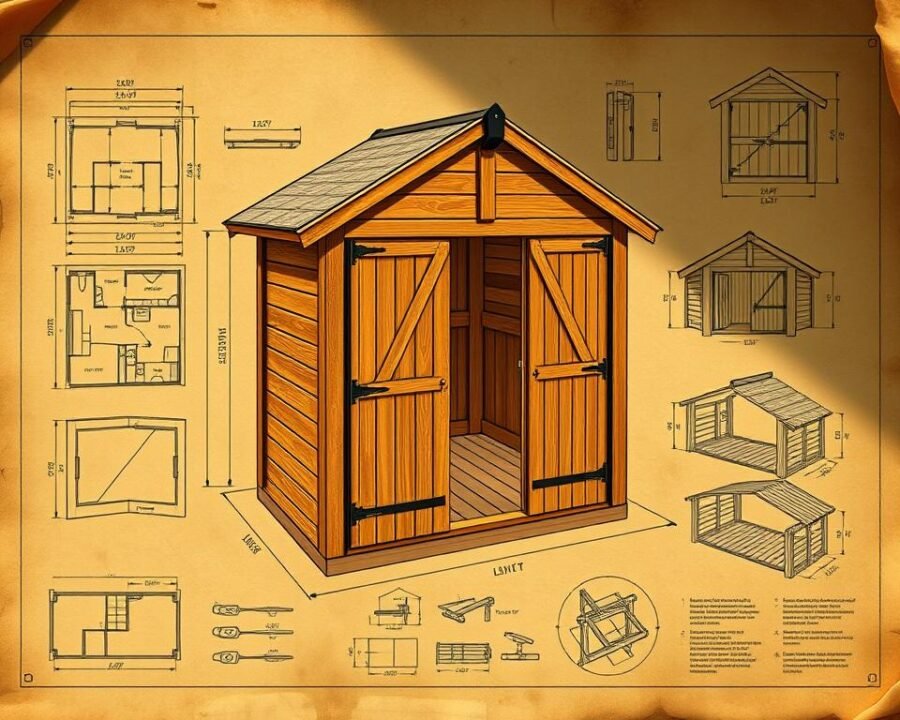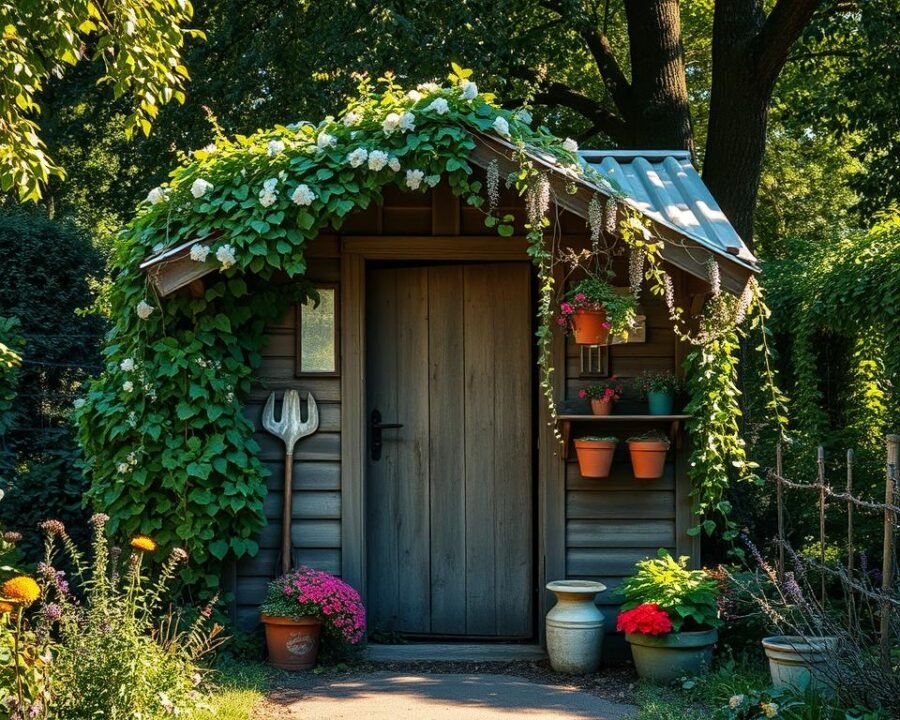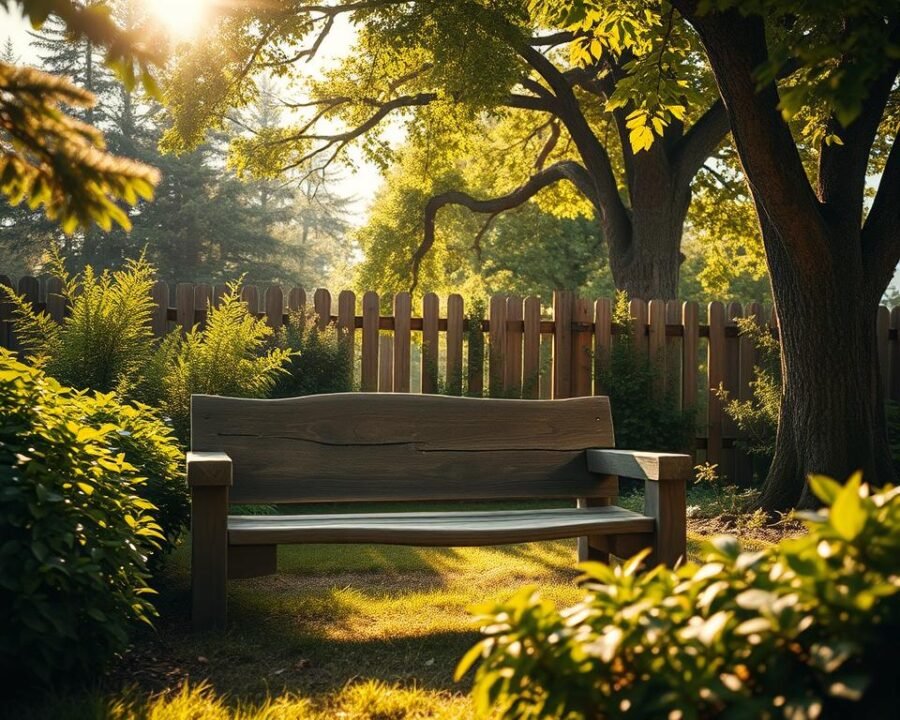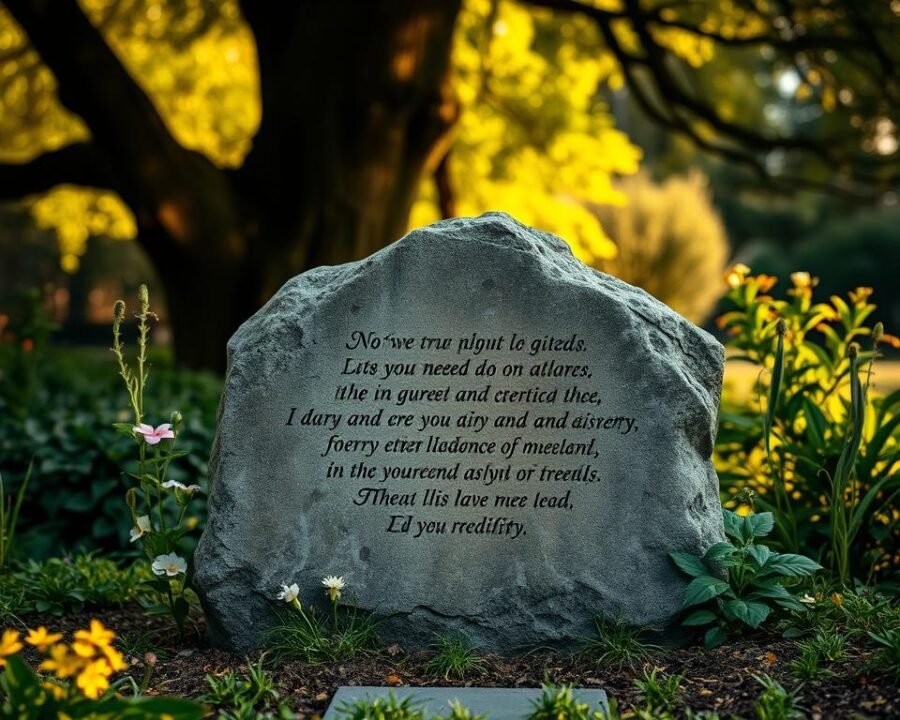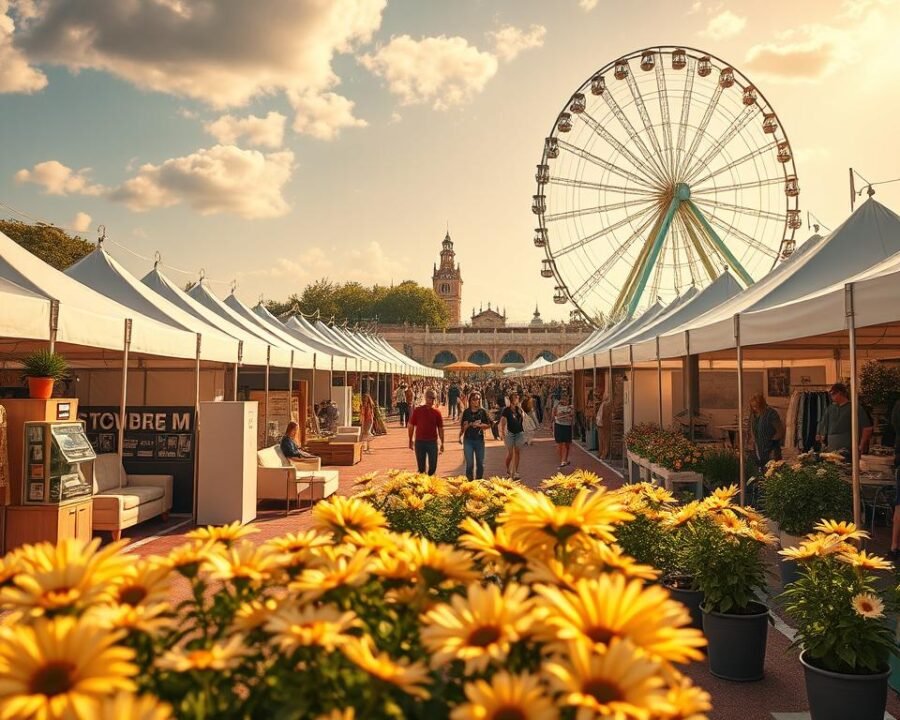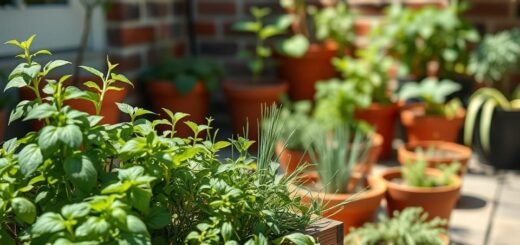Create the Perfect English Garden Shed
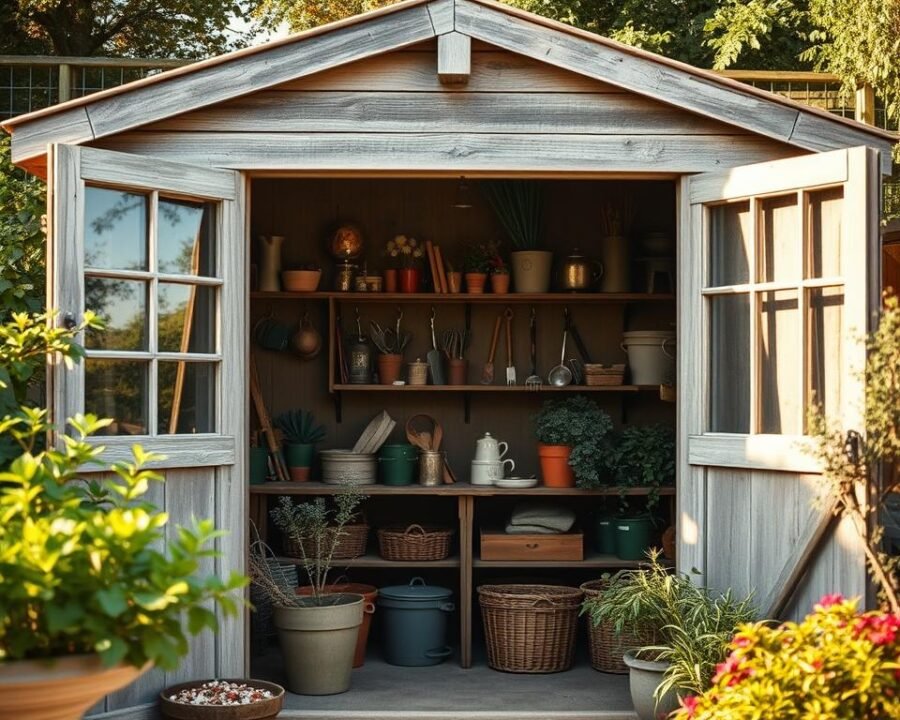
Building an English garden shed is a special project that needs careful planning. It’s more than just a place to store things. It’s a chance to create a charming spot in your yard that shows off your style.
A well-made outdoor storage solution can become a highlight of your home. For example, a shed can look great with vintage doors and windows. It can also be surrounded by green plants, like in this English cottage flower garden shed reveal.
Key Takeaways
- Careful planning is essential for creating a charming English garden shed.
- A well-designed shed can become a beautiful destination in your yard.
- Outdoor storage solutions can be both functional and aesthetically pleasing.
- Vintage elements can add character to your garden shed.
- Surrounding your shed with lush greenery can enhance its charm.
The Charm and Utility of English Garden Sheds
An English garden shed is more than a place to store things. It’s a special spot for gardeners. These structures have been a key part of English gardens for centuries. They mix usefulness with beauty.
Historical Significance of Garden Sheds in English Culture
Garden sheds have a long history in English culture. They started in the 17th and 18th centuries as storage and workspaces for gardeners. Now, they’re a big part of garden design, showing how tastes and needs have changed.
Today, they’re a key part of English gardens. They show a love for gardening and a connection to the past.
The design of these sheds reflects their history. They use traditional materials and styles. This mix of old and new gives them a unique, charming look that’s very English.
Modern Interpretations and Uses
Nowadays, English garden sheds do more than just store things. They’re used as potting sheds, for storing outdoor furniture, and even as hobby spaces or home offices. Their flexibility makes them a favorite among gardeners and homeowners.
| Modern Use | Description |
|---|---|
| Potting Shed | A space dedicated to nurturing plants, with shelving for pots and gardening tools. |
| Storage | A practical solution for storing outdoor furniture, gardening equipment, and other items. |
| Hobby Space/Home Office | A quiet, secluded area for pursuing hobbies or working from home. |
Planning Your English Garden Shed Project
To build a beautiful and functional English garden shed, start with a solid plan. You need to decide on the size and location of the shed. Also, understand local building codes and set a budget. A well-planned shed adds beauty to your garden and provides useful storage.
Determining the Ideal Size and Location
When picking the perfect size and spot for your shed, many things matter.
Assessing Available Space
First, look at the space in your garden. Think about what you’ll store and the shed’s purpose.
Choose a spot that’s level, dry, and easy to get to. Use DIY shed plans to see how the shed will fit.
Considering Sun Exposure and Drainage
Think about sun and drainage too. A shaded shed might get damp, while a sunny one can get too hot. Good drainage stops water from gathering around the shed.
A gardening expert says, “A well-designed garden shed is more than storage. It’s a key part of the garden’s look.”
A garden shed should complement the garden’s landscape, rather than dominating it.
Understanding Local Building Codes and Permits
Before starting, know the local building codes and permits needed. Check with local authorities to see if you need a permit. Not following rules can lead to fines or even the shed being torn down.
| Permit Type | Description |
|---|---|
| Building Permit | Required for shed construction |
| Zoning Permit | Ensures compliance with local zoning regulations |
Setting a Realistic Budget and Timeline
Having a realistic budget and timeline is key to a successful project. Figure out the costs of materials and labor. Add extra money for surprises. A good budget keeps costs down and ensures you finish on time.
By following these tips, you can build a beautiful English garden shed. Think about size, location, and local rules. With careful planning, you’ll have a wonderful garden shed.
Essential Design Elements of an Authentic English Garden Shed
An authentic English garden shed is more than a storage space. It’s a charming addition that reflects English country gardening’s classic style. To create such a shed, consider several key design elements that bring the traditional charm of English gardens to life.
Classic Architectural Features
Classic architectural features are crucial in defining an English garden shed’s character. These include cottage-style elements and Victorian influences. They are essential to the traditional English garden aesthetic.
Cottage-Style Elements
Cottage-style elements, like a gabled roof, wooden doors, and multi-paned windows, make an English garden shed cozy and inviting. These features are typical of traditional English cottages and enhance the shed’s charm.
Victorian Influences
Victorian influences, such as intricate woodwork and ornate details, can also be added to an English garden shed’s design. These elements bring elegance and sophistication, reflecting the Victorian era’s ornate style.
Window and Door Placement
The placement of windows and doors is key to creating a welcoming and functional English garden shed. Windows should be placed to maximize natural light and views. Doors should be positioned for easy access to the shed and the garden.
Roof Styles and Materials
The roof style and material greatly impact an English garden shed’s appearance. Traditional roof styles include gabled, gambrel, and saltbox roofs. Materials like wood, metal, and clay tiles can create a rustic or elegant look. For a rustic garden shed, a wooden roof with a gabled or gambrel style is fitting.
When designing your garden shed decor, consider the design elements carefully. Incorporate classic architectural features, thoughtful window and door placement, and a suitable roof style and material. This way, you can create an authentic English garden shed that enhances your garden and offers a charming storage space.
Selecting the Right Materials for Your English Garden Shed
Choosing the right materials is key for a garden shed that looks good and works well. The materials you pick affect how long the shed lasts and how easy it is to keep up. They also impact how the shed looks in your garden.
When building an English garden shed, picking the right materials is very important. We’ll look at wood, roofing, and hardware to guide you. This will help you pick the best materials for your outdoor storage needs.
Wood Options and Treatments
Wood is a classic choice for garden sheds because it looks great and is versatile. Different woods have their own benefits. Knowing these can help you choose the best wood for your shed.
Cedar vs. Pine vs. Composite
Cedar, pine, and composite woods are common for garden sheds. Cedar fights off rot and bugs well, while pine is cheaper and can be treated. Composite is a mix of wood and other stuff, making it easy to care for. Your choice depends on what you value most: cost, upkeep, or looks.
Weather-Resistant Finishes
It’s important to use a weather-resistant finish on your wood shed. You can use stains and sealants to protect the wood and make it look better. The right finish depends on the wood type and the look you want for your shed.
Roofing Materials
The roofing material is key for keeping your shed dry and strong. You can choose from asphalt shingles, metal, or translucent panels for light. Think about weather resistance, cost, and design when picking your roofing.
Hardware and Fixtures
Choose durable and rust-resistant hardware like hinges, handles, and nails. Good hardware makes your shed work well and look good for a long time.
By picking the right materials for your English garden shed, you get a strong, pretty, and useful outdoor storage spot. It will enhance your garden and serve you well for many years.
Step-by-Step Construction Guide
Building your English garden shed is easier with a clear plan. The process includes several steps, from foundation preparation to roof and exterior finishes.
Preparing the Foundation
A solid foundation is key for your shed’s stability and life span. You can choose between a concrete slab or a pier foundation.
Concrete Slab Options
A concrete slab foundation is solid and can look great, perfect for bigger sheds. It needs careful prep, like clearing the area and pouring concrete.
Pier Foundation Techniques
A pier foundation is simpler and cheaper, great for smaller sheds. It involves digging holes, filling them with concrete, and building the floor on top.
Framing the Structure
After preparing the foundation, start framing. Use timber to build walls and the roof, following your DIY plans. Make sure the frame is square and level for a strong base.
Installing Walls, Windows, and Doors
With the frame ready, install walls, windows, and doors. Pick materials that match your backyard shed design. Make sure windows and doors let in light and are easy to access.
| Component | Material Options | Considerations |
|---|---|---|
| Walls | Timber, metal, or composite materials | Durability, maintenance, and aesthetic appeal |
| Windows | Wooden, aluminum, or PVC frames | Light transmission, ventilation, and energy efficiency |
| Doors | Wooden, metal, or fiberglass | Security, durability, and style |
Completing the Roof and Exterior Finishes
The last steps are the roof and exterior finishes. Pick a roofing material that matches your shed’s look, like asphalt shingles. Make sure exterior finishes, like cladding, are weather-resistant and durable.
Creating the Perfect Interior for Your English Garden Shed
To make the most of your garden shed, a well-designed interior is key. A functional and comfortable space comes from several elements. These include insulation, flooring, and lighting.
Insulation and Weatherproofing Options
A well-insulated garden shed keeps a comfortable temperature and saves energy. You can choose from insulation like fiberglass batts, foam board, and reflective insulation. Weatherproofing is also crucial to keep your shed dry and secure. Use weather-resistant materials and finishes for this.
Flooring Solutions
The flooring of your garden shed greatly affects its functionality and look. You can choose from traditional wood planking or modern alternatives.
Traditional Wood Planking
Wood planking is a classic choice for garden shed flooring. It brings warmth and character. With care, it can last for many years.
Modern Alternatives
For a modern look, consider laminate or vinyl flooring. These are durable and easy to keep clean. They’re perfect for busy garden sheds.
Lighting and Electrical Considerations
Good lighting is crucial for a functional garden shed. LED lighting is energy-efficient and lasts long. You might also need electrical outlets for tools and equipment. Always follow safety rules when installing electrical parts.
By focusing on these elements, you can make a beautiful and useful garden shed. It can be for storage, hobbies, or a quiet retreat. A well-designed interior is essential.
When designing your garden shed interior, add your personal style. With creativity, you can make it a cozy retreat for years.
| Flooring Option | Durability | Maintenance |
|---|---|---|
| Traditional Wood Planking | High | Regular maintenance required |
| Laminate Flooring | Medium | Easy to maintain |
| Vinyl Flooring | High | Easy to maintain |
Decorating and Personalizing Your Garden Shed
Turning your garden shed into a cozy retreat needs careful thought. A well-decorated shed can be a place to relax and show off your style.
Color Schemes and Paint Selection
Picking the right colors is key for your shed’s feel. Traditional English colors are soft and blend well with nature.
Traditional English Color Palettes
Think about using classic colors like sage green, weathered wood, and soft grays. These colors make your shed welcoming and cozy.
Application Techniques
For a smooth finish, use top-notch paint and mix brushwork with texture. This method ensures your shed looks great for years.
Adding Vintage and Rustic Touches
Adding vintage and rustic elements brings charm to your shed. Think about using reclaimed wood, old fixtures, and distressed finishes.
Some ideas include:
- Using old wooden crates or pallets for shelving or storage
- Adding antique door hardware or hinges for a unique look
- Using distressed or reclaimed wood for design
Incorporating Plants and Natural Elements
Bring the outdoors in by adding plants and natural elements. You can do this with:
| Element | Description |
|---|---|
| Greenery | Add plants or a living wall to blend your shed with the outdoors. |
| Natural Materials | Use wood, stone, or brick for a natural and earthy feel. |
| Water Features | Consider a small water feature like a birdbath or fountain for a calming effect. |
Landscaping Around Your English Garden Shed
Landscaping around your English garden shed is key to a welcoming outdoor space. A well-designed landscape not only matches the shed but also boosts your garden’s beauty.
Complementary Plant Selection
Choosing the right plants is crucial for a cohesive look. Pick plants that match your shed’s color and style.
Climbing Vines and Roses
Climbing vines and roses add elegance to your garden shed. They can climb up the shed or nearby structures, showing off color and texture.
Perennial Border Plants
Perennial border plants are a smart choice for your shed. They offer vibrant colors all season and need little care.
Creating Pathways and Borders
Pathways and borders define the space around your shed. Use stone, gravel, or brick for a nice pathway to your shed.
Seasonal Considerations for Year-Round Appeal
To keep your garden shed looking good all year, think about the seasons. Pick plants and features that are interesting and beautiful at different times.
| Season | Plants and Features |
|---|---|
| Spring | Blooming flowers, greenery |
| Summer | Vibrant colors, lush foliage |
| Autumn | Fall colors, changing foliage |
| Winter | Evergreen plants, snow-covered landscapes |
Maintenance Tips for Long-Lasting Garden Sheds
Keeping your garden shed in good shape is important. It’s not just about looks; it’s also about how well it works and lasts. Regular care is key to making your shed last longer and stay looking great.
Start by making a seasonal maintenance schedule. This plan should include checking the roof, making sure doors and windows work right, and keeping the foundation steady. This helps catch problems early and fix them before they get worse. For tips on getting your shed ready for each season, see our guide on waterproofing a garden shed.
Seasonal Maintenance Schedule
Having a seasonal maintenance plan is essential. In spring, check for winter damage. In summer, make sure it’s well-ventilated to avoid moisture. In fall, clean it out for winter. In winter, look for damage from snow and ice.
Preventing Rot and Pest Damage
Stopping rot and pests is critical. Regularly check for signs of rot or pests and fix any problems fast. Use treated wood and weather-resistant materials to protect it. Also, keep it tidy to prevent pests.
Refreshing and Updating Your Shed
Updating your shed is easy. Just paint it or change the hardware. Add garden shed organization ideas like shelves or bins to keep it neat. You can also spruce up the outside with new doors or windows.
Conclusion: Enjoying Your Perfect English Garden Shed
As we wrap up our guide to the perfect English garden shed, we think about what makes it special. It’s all about planning, design, and using quality materials. This way, we’ve made a space that’s not just for storage but also adds to our garden’s beauty.
Our english garden shed is more than a place to store things. It shows off our style and our love for nature. It can be a quiet spot, a place to create, or a spot to keep things organized. It’s a key part of our garden’s appeal.
Now that we have our english garden shed, we see how it makes our outdoor space better. With some upkeep and creativity, it will stay a favorite spot in our garden. It offers a peaceful place to relax and boosts our pride in our outdoor storage.
FAQ
What is an English garden shed?
An English garden shed is a charming outdoor storage solution. It adds beauty to your garden. It often has classic architectural elements and rustic touches.
What are the benefits of having an English garden shed?
An English garden shed offers extra storage space. It also makes your garden look better. Plus, building one can be a fun project.
How do I determine the ideal size and location for my English garden shed?
First, think about the space you have in your garden. Then, consider what you’ll use the shed for. Lastly, check local building codes and permits.
What design elements are essential for an authentic English garden shed?
Key design elements include cottage-style and Victorian influences. Also, think about window and door placement. And don’t forget about roof styles and materials.
What materials are suitable for building an English garden shed?
Good materials include cedar, pine, and composite materials. Also, choose weather-resistant finishes and durable roofing.
How do I construct an English garden shed?
Start by preparing the foundation. Then, frame the structure. Next, install walls, windows, and doors. Finally, complete the roof and exterior finishes.
How can I create a cozy and functional interior for my English garden shed?
For a cozy interior, consider insulation and weatherproofing. Choose the right flooring and lighting. And think about electrical needs.
How can I decorate and personalize my English garden shed?
Pick a color scheme and paint that suits you. Add vintage and rustic touches. And include plants and natural elements.
What are some landscaping ideas around my English garden shed?
Choose plants that complement your shed. Create pathways and borders. And think about seasonal changes for year-round beauty.
How do I maintain my English garden shed?
Create a maintenance schedule for each season. Prevent rot and pest damage. And update your shed as needed.
What are some tips for small shed landscaping?
Use compact plants for small spaces. Create a simple pathway. And add natural elements for beauty.
How can I ensure my English garden shed is weather-resistant?
Use weather-resistant finishes and durable roofing. Also, ensure proper insulation and weatherproofing.
